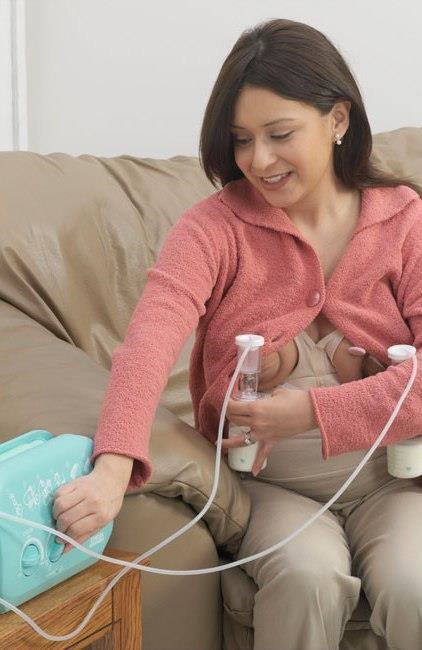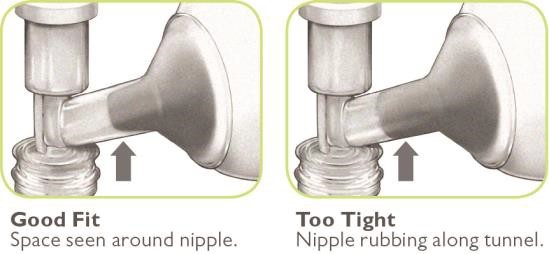No doubt about it, returning to work can be a stressful situation and an emotional one for you. You may experience some conflicting emotions: guilt for leaving your new baby and maybe being glad to get out the house and "life as usual" at work.
The American Academy of Pediatrics encourages mothers to provide breastmilk for the first six months of your baby's life for optimum health, and to continue for the first year or longer) as you add more solid foods to his diet after about 6 months.
The good news is you CAN do it. You will find that motherhood helps you increase your efficiency and you learn to better manage your time both at home and at work. You become more organized because there is no extra time in your day to waste!
The American Academy of Pediatrics encourages mothers to provide breastmilk for the first six months of your baby's life for optimum health, and to continue for the first year or longer) as you add more solid foods to his diet after about 6 months.
The good news is you CAN do it. You will find that motherhood helps you increase your efficiency and you learn to better manage your time both at home and at work. You become more organized because there is no extra time in your day to waste!
Getting Ready
Choosing someone to care for your baby is one of your most important decisions. You may select someone close to your home or close to your workplace If care is available in your workplace, that is ideal since you could breastfeed at work.
Purchase the best pump you can afford. It will be worth it. Or you may choose to rent a breast pump for as long as you plan on breastfeeding. The better quality pump you use, the better you will be able to maintain your breastmilk supply. Select one that can pump both sides at the same time.
There are hospital grade breast pumps, personal use pumps, small electric and battery operated pumps and manually operated pumps. A rental hospital grade pump or a personal use breast pump are most suitable for a mother who wishes to maintain her supply by pumping at work. Commonly recommended pumps are Medela and Ameda, but there are many other brands on the market you might select.
Talk to your employer about a private, clean place that you can use your pump. Some employers have a designated room, and some even provide a hospital grade breast pump for the use of several women. Make sure you know how to attach your pump kit and how to use the pump. You may want to do a practice run, timing how long it takes to travel, locating where you can store your milk, and using your breast pump.
Although it is not required, you may want to stockpile some milk prior to returning to work to use as a “back-up”. About 2 weeks’ worth of milk in your freezer will give you confidence (about 60 oz) that you have some breastmilk to fall back on if you are not able to pump quite enough as you get adjusted to the new routine.
Choosing someone to care for your baby is one of your most important decisions. You may select someone close to your home or close to your workplace If care is available in your workplace, that is ideal since you could breastfeed at work.
Purchase the best pump you can afford. It will be worth it. Or you may choose to rent a breast pump for as long as you plan on breastfeeding. The better quality pump you use, the better you will be able to maintain your breastmilk supply. Select one that can pump both sides at the same time.
There are hospital grade breast pumps, personal use pumps, small electric and battery operated pumps and manually operated pumps. A rental hospital grade pump or a personal use breast pump are most suitable for a mother who wishes to maintain her supply by pumping at work. Commonly recommended pumps are Medela and Ameda, but there are many other brands on the market you might select.
Talk to your employer about a private, clean place that you can use your pump. Some employers have a designated room, and some even provide a hospital grade breast pump for the use of several women. Make sure you know how to attach your pump kit and how to use the pump. You may want to do a practice run, timing how long it takes to travel, locating where you can store your milk, and using your breast pump.
Although it is not required, you may want to stockpile some milk prior to returning to work to use as a “back-up”. About 2 weeks’ worth of milk in your freezer will give you confidence (about 60 oz) that you have some breastmilk to fall back on if you are not able to pump quite enough as you get adjusted to the new routine.
 Pumping
PumpingPlan to use a breast pump the same number of times that the baby will be feeding while you are gone. That may be 2-4 times. Try to maintain a routine in your scheduled pumping sessions. Avoid skipping or postponing pumping. Doing this too often will affect your milk supply. Do the best you can. If you have a long commute added to your work day, try to add another pumping session. The more you pump the more milk you will make, so make a priority of pumping on a regular basis. Pump 2-3 times per day.
Start the suction on low each time you pump and gradually increase the suction (over the first 2-3 minutes) to the maximum setting that is comfortable for you. That is different for everyone. The pump is pre-set to the strength of a normal infant's suck so it is unlikely you will find it too strong. If you do, stop increasing the suction just when it begins to pinch. Too much suction can collapse your milk ducts and result in poor milk emptying.
Do a 10–15 minute session or watch for 2-3 let- down reflexes (time when the milk is flowing faster, then it will slow down again). Pump for 2-3 minutes after the last drops of milk. If you are pressed for time, short frequent sessions are better than just one long one.
Do a 10–15 minute session or watch for 2-3 let- down reflexes (time when the milk is flowing faster, then it will slow down again). Pump for 2-3 minutes after the last drops of milk. If you are pressed for time, short frequent sessions are better than just one long one.
Maintaining your breastmilk supply
Pump regularly and breastfeed when you are at home. That is the best way to keep up an abundant milk supply. If you see your supply wane during the week, breastfeed exclusively on your days off and do a bit of extra pumping if you have time.
Mother’s Milk Tea, cooked oatmeal and an occasional beer are common recommendations to increase breastmilk supply. If you need additional help, contact a lactation consultant.
Leaking at work
Most women have no trouble with this, but it can be embarrassing. If you do occasionally leak, have a ready source of breast pads, re-usable or disposable. For more problematic leaking, try Lily- Padz or Blis Leakage Inhibitor.
Mother’s Milk Tea, cooked oatmeal and an occasional beer are common recommendations to increase breastmilk supply. If you need additional help, contact a lactation consultant.
Leaking at work
Most women have no trouble with this, but it can be embarrassing. If you do occasionally leak, have a ready source of breast pads, re-usable or disposable. For more problematic leaking, try Lily- Padz or Blis Leakage Inhibitor.
Make sure your pump kit fits you
You should see your nipple move in and out with each suction cycle. There should be no white ring round the nipple and your breasts should empty completely. If it hurts or you are not getting milk, it is probably too small and you need larger flanges. They can be obtained from hospitals, lactation consultants and on- line stores.
You should see your nipple move in and out with each suction cycle. There should be no white ring round the nipple and your breasts should empty completely. If it hurts or you are not getting milk, it is probably too small and you need larger flanges. They can be obtained from hospitals, lactation consultants and on- line stores.
Your flange fits you if:
- Your nipple moves in and out with each suction/release phase
- Your breast empties all over, no pockets of hardness
- The flange supports the breast and areola, none of the areola is pulled into the nipple tunnel
- There is slight movement in the breast with each cycling of the pump
- The nipple is not sore or cracked and there is no pressure ring or blanched skin around the nipple

Storing your milk:
You may just close your bottle of pumped breastmilk with a tightly fitting lid and put it in your purse to take home. Or you can use plastic mother’s milk bags.
Freshly pumped breastmilk is good at room temperature for 4 hours. Or you may choose to chill it for the trip home if it will be longer than 4 hours. Freezer packs are handy for this and come with most personal use pumps.
Breastmilk stored in the refrigerator is good for 5-7 days
Breastmilk can be frozen for 3-6 months. Once you have thawed previously frozen breastmilk, it is only good for 24 hours!
It is a good idea at first to keep milk in small quantities until you have a good idea of how much your baby will take at one time. Milk left over in the bottle must be discarded if not consumed. You will hate to do that! Choose bottles that are not made of polycarbonate due to the concerns about BPA contamination of breastmilk stored and heated in them.
You may just close your bottle of pumped breastmilk with a tightly fitting lid and put it in your purse to take home. Or you can use plastic mother’s milk bags.
Freshly pumped breastmilk is good at room temperature for 4 hours. Or you may choose to chill it for the trip home if it will be longer than 4 hours. Freezer packs are handy for this and come with most personal use pumps.
Breastmilk stored in the refrigerator is good for 5-7 days
Breastmilk can be frozen for 3-6 months. Once you have thawed previously frozen breastmilk, it is only good for 24 hours!
It is a good idea at first to keep milk in small quantities until you have a good idea of how much your baby will take at one time. Milk left over in the bottle must be discarded if not consumed. You will hate to do that! Choose bottles that are not made of polycarbonate due to the concerns about BPA contamination of breastmilk stored and heated in them.

